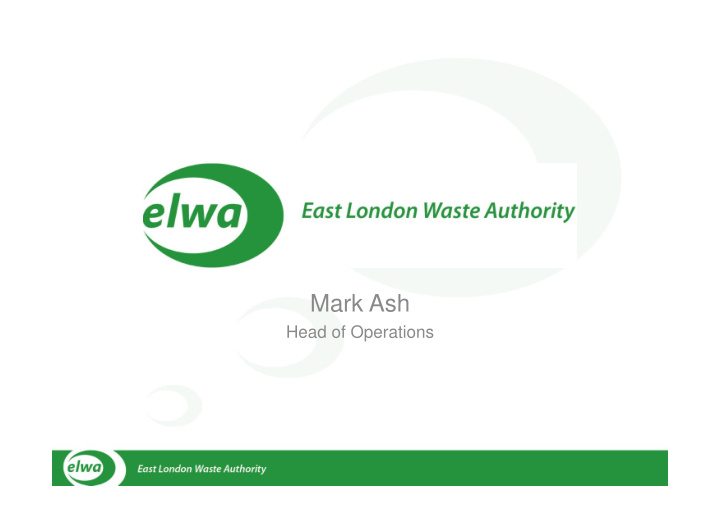



ELWA Mark Ash Head of Operations
East London Waste Authority • ELWA established on 1st April 1986 following abolition of GLC. – statutory waste disposal authority – London Boroughs of, Barking & Dagenham, Havering, Newham and Redbridge,. – 2 elected members per borough – 6 officers • ELWA responsible for disposal. – Boroughs for collection.
Contract Arrangements ELWA Shanks Waste ELWA Management Barking & Ltd Dagenham Shanks East Contract Contract London Havering Newham John Laing ‘A’ Directors Director & Equity plc Redbridge
Reuse and Recycling Centres
Background to Changes • The cost of waste disposal has risen significantly year on year. Minimising the waste that needs to be processed is an obvious means of making savings. • Significant risk that residents from surrounding boroughs have been using ELWA’s RRCs. – Chigwell Road - border of Waltham and Epping Forest; – Gerpins Lane – border of Thurrock. • The waste disposal cost ultimately falls on ELWA residents. • A charge on non ELWA residents would mean all additional costs were covered.
Landfill tax increase 70 60 50 40 Standard Rate (£ per tonne) 30 20 10 0
CA sites feel force of council spending cuts “Thurrock, have already unveiled which sites face the chop. The Essex unitary authority announced at the end of September that the St Clements Way household waste recycling centre in the west of the unitary authority would be ‘mothballed' in a bid to save £135,000 per year. “ Lets recycle.com 16 th December 2010
Communicating the Change • A flyer was handed out at all RRCs two weeks prior to the start date. • A half page advert was placed in five publications with circulation in the boroughs (Living) and surrounding areas. • Signage was installed at the site. • The council’s & ELWA’s websites were updated with further information. • All councillors were written to by the ELWA chairman. • All council tax payers received a leaflet with their annual demand.
Monitoring & Controls • ELWA set up a dedicated help line for any questions or complaints. • We spoke to ELWA residents which revealed that the majority are happy to see measures being taken to reduce their costs. • Queues, which were expected to be a potential problem at first, had been only a minor issue. • At an early stage it was decided that asking for both forms of ID was overly demanding. As such, the requirement was reduced to one or the other. • ELWA has had no reports of an increase in fly-tipping in any of the boroughs.
Temporary Disclaimer Any ELWA residents who visited the RRC without being aware of the changes were asked to complete a disclaimer form in lieu of ID to use the site. This allowed them access to tip their waste on that occasion, and they are provided with the flyer asking them to provide ID in future. This was discontinued after a set time.
10,000.00 1,000.00 2,000.00 3,000.00 4,000.00 5,000.00 6,000.00 7,000.00 8,000.00 9,000.00 0.00 Apr ‐ 10 May Effect of Change Overall June July August September October November December January February March Apr ‐ 11 May June July Tonnage August September October November December January February March Apr ‐ 12 May June July August September October November December Tonnage
Effect of Change Locally Gerpins Lane 4,000.00 3,500.00 3,000.00 2,500.00 Tonnage 2,000.00 1,500.00 1,000.00 500.00 0.00 Month
Effect of Change Overall • May 2010 – April 2011 RRC Tonnage 79,221t • May 2011 – April 2012 RRC Tonnage 59,371t • Waste Tonnage Reduction of 19,850t • Equates to a 25% reduction in tonnes • Equates to almost £1.2m saving in disposal cost!
Is It Perfect? • In short No, but it is significantly better! • There is still trade waste entering the site. • There are still non residents using the site. • The site layout could be better. • Waste segregation could be better. • Signage could be better. • Etc, etc, etc…….
A Balancing Act Pareto Principle - 80% of consequences stem from 20% of the causes 80% of the 80% of users are problems compliant are caused therefore only by 20% of 20% are not the users
So What Now? • Ongoing monitoring and communication • Less traffic + Less Waste = More Opportunity • (Facilitated by a change in personnel) – Better waste segregation – Changed Layouts – Improved interaction with the public – More time to inspect for trade waste – Better reuse facilities – Improved signage – Openness to constructive ideas and suggestions
Any Questions?
More recommend